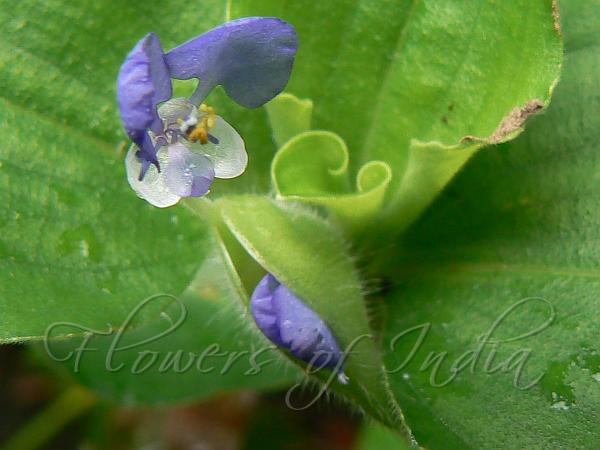|
| Bengal Dayflower |
|

|

| File size | 225067 |
| Original date | 9/23/07 10:52 AM |
| Resolution | 1200 x 900 |
| Flash | Flash did not fire, auto |
| Focal length | 6.0mm |
| Exposure time | 1/100s |
| Aperture | 5.0 |
| Focus Distance | |
| Metering Mode | Multi-segment |
| Camera make | Panasonic |
| Camera model | DMC-FZ7 |
| Sensor type | OneChipColorArea |
|
|
|
|
Photo: |
Botanical name: Commelina benghalensis Family: Commelinaceae (Dayflower family)
Synonyms: Commelina canescens, Commelina cucullata, Commelina hirsuta
Synonyms: Commelina canescens, Commelina cucullata, Commelina hirsuta
Bengal Dayflower is a diffuse herb, rooting at
lower nodes, rootstock with self-pollinating flowers. Leaves are 3-5 x
2-3.5 cm, ovate or elliptic-ovate, base rounded or almost flat, tip
blunt or pointed, velvet-hairy, margin frilly, stalk up to 8 mm long,
sheath up to 1.5 cm long, tip with rusty hairs. Spathe is about 1.5 cm
across, funnel-shaped, flat at apex, velvet-hairy. Sepals are nearly
equal, about 2.5 mm long, outer ones linear, inner ones orbicular.
Petals are blue, larger ones about 4 x 4.5 mm, broadly ovate. Stamens
are 3, staminodes 2, ovary up to 1mm long. Capsule is up to 5 mm long,
ellipsoid, 3-celled. Seeds are 5, pitted. Bengal Dayflower is a
wide-ranging plant, being native to tropical and subtropical Asia and
Africa, an area otherwise known as the paleotropics.
| Identification credit: Tabish | Photographed in Maharashtra. |
• Is this flower misidentified? If yes,